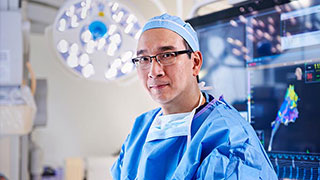Expert Care for a Complex Heart Abnormality
Transposition of the great arteries is the most common cyanotic (low blood
oxygen) congenital heart
condition.
Normally, the pulmonary artery comes from the right ventricle to pump
deoxygenated blood to the lungs to get oxygen, while the aorta comes from
the left ventricle to pump oxygenated blood from the lungs to the rest of
the body.
In patients with TGA, these “great arteries” are switched. The aorta comes from
the right ventricle and pumps deoxygenated blood to the body, while the
pulmonary artery comes from the left ventricle and pumps deoxygenated and
oxygenated blood to the lungs.
To survive without treatment, patients must have an additional heart defect
that allows the heart’s right and left sides to communicate so that blood can
mix. This defect can be an atrial septal defect, ventricular septal defect, or a patent ductus arteriosus.
As with most congenital heart defects, the cause of TGA is unknown. Occurring
primarily in males, the condition has a 90 percent mortality rate within the
first year of life, if left untreated.
UT Southwestern’s specialized heart doctors expertly diagnose and treat transposition
of the great arteries. Our experienced cardiologists and cardiothoracic
surgeons offer the most advanced treatments and technologies, personalized for each
patient’s unique condition.
UT
Southwestern is also home to a dedicated Cardiac Rehabilitation Program. Cardiac rehabilitation is a
critical component of recovery and can prevent future heart disease.
Symptoms of Transposition
of the Great Arteries (TGA)
Cyanosis – a bluish color to the skin caused by insufficient oxygenation –
is the primary symptom of TGA, and it is usually noticeable at birth or shortly
thereafter. Its severity depends on the size and type of any heart abnormalities
and how much oxygen is moving through the patient’s body:
- TGA with no additional
heart defect: Severe cyanosis in the first 24 hours of life
- TGA with a large
ventricular septal defect (VSD): Mild cyanosis when crying, increased breathing
and heart rates, sweating, and failure to gain weight in the first six weeks of
life
- TGA with VSD and
obstruction in the left ventricle: Extreme cyanosis at birth
- TGA with VSD and
pulmonary artery obstruction: Progressive cyanosis from birth
Diagnosing TGA
UT Southwestern cardiologists might perform several tests to diagnose TGA. Common
diagnostic tests include:
- Physical exam: Determines
whether the patient’s mouth and skin are blue or if a heart murmur can be heard
with a stethoscope
- Echocardiography: A noninvasive imaging test that shows the TGA and
sometimes other heart defects
- Cardiac catheterization: Usually performed
in infants whose echocardiograms don’t provide enough information about the
heart’s anatomy
- Hyperoxia test:
Shows oxygen saturation in blood
Treatments for
TGA
Treatments for transposition of the great arteries include:
- Arterial switch
surgery: Corrects the defect by detaching the pulmonary artery and aorta from the
wrong ventricles and attaching them to the correct ventricles, enabling the
heart to receive proper blood flow
- Balloon septostomy: Increases the size of the hole between the right and
left atria to enable more mixing of oxygenated and deoxygenated blood
- Intravenous prostaglandin
E1 therapy: Helps the patent ductus arteriosus stay open and enables
more mixing of oxygenated and deoxygenated blood
Support Services
UT
Southwestern’s cardiac rehabilitation specialists create customized plans that
integrate proper nutrition, exercise, and, if necessary, nicotine cessation
into patients’ lifestyles to improve their cardiovascular health.
Clinical
Trials
As one of the nation’s top academic medical centers, UT Southwestern offers a
number of
clinical trials aimed at improving the outcomes of patients with
cardiovascular disease.
Clinical
trials often give patients access to leading-edge treatments that are not yet
widely available. Eligible patients who choose to participate in one of UT
Southwestern’s clinical trials might receive treatments years before they are
available to the public.





